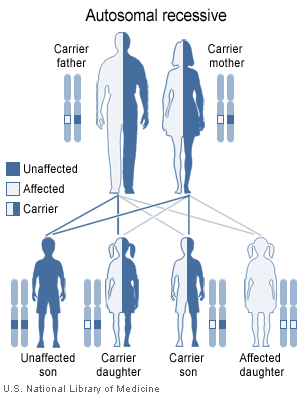Jervell and Lange-Nielsen syndrome
| Jervell and Lange-Nielsen syndrome | |
| ICD-9 | 426.82 |
|---|---|
| OMIM | 220400 |
| DiseasesDB | 7249 |
| MeSH | D029593 |
Editor-In-Chief: C. Michael Gibson, M.S., M.D. [1]; Associate Editor(s)-in-Chief:
Synonyms and keywords:Autosomal recessive long QT syndrome (LQTS), cardioauditory syndrome, cardioauditory syndrome of Jervell and Lange-Nielsen, deafness, congenital, and functional heart disease, Jervell and Lange-Nielsen (JLNS), surdocardiac syndrome
Overview
Jervell and Lange-Nielsen syndrome is a rare autosomal recessive condition that leads to sensorineural deafness, long QT syndrome (LQTS) and other cardiac events. Jervell and Lange-Nielsen syndrome is due to KCNQ1 or KCNE1 gene mutations. The range of symptoms and severity of symptoms in Jervell and Lange-Nielsen syndrome differs from patient to patient.
Historical Perspective
- Jervell and Lange-Nielsen syndrome (JLNS) was first discovered by Anton Jervell a Norwegian physician and Fred Lange-Nielsen a Norwegian doctor and jazz musician, in 1957.[1]
Classification
| Type | Chromosome Locus | Gene Mutation | Protein Involved |
| Jervell and Lange-Nielsen syndrome 1 | 11p15.5-p15.4 | KCNQ1 | Potassium voltage-gated channel subfamily KQT member 1 |
| Jervell and Lange-Nielsen syndrome 2 | 21q22.12 | KCNE1 | Potassium voltage-gated channel subfamily E member 1 |
Pathophysiology
Physiology
The normal physiology of [name of process] can be understood as follows:
Pathogenesis
- The exact pathogenesis of [disease name] is not completely understood.
OR
- It is understood that Jervell and Lange-Nielsen syndrome (JLNS) is the result of mutations in the gene KCNQ1 and KCNE1
- KCNQ1 gene normally consists of 16 exons and have a general spanning of 400 kb.
- The normal gene product of KCNQ1 gene is potassium voltage-gated channel subfamily KQT member 1.
- When KCNQ1 gene undergoes frameshift mutation it results in yielding truncated protein.
- Then the truncated protein either delete or duplicate the exons of the KCNQ1 gene and results in abnormal gene product which is known to result in long QT syndrome.
- [Pathogen name] is usually transmitted via the [transmission route] route to the human host.
- Following transmission/ingestion, the [pathogen] uses the [entry site] to invade the [cell name] cell.
- [Disease or malignancy name] arises from [cell name]s, which are [cell type] cells that are normally involved in [function of cells].
- The progression to [disease name] usually involves the [molecular pathway].
- The pathophysiology of [disease/malignancy] depends on the histological subtype.
Genetics
[Disease name] is transmitted in [mode of genetic transmission] pattern.
OR
Genes involved in the pathogenesis of [disease name] include:
- [Gene1]
- [Gene2]
- [Gene3]
OR
The development of [disease name] is the result of multiple genetic mutations such as:
- [Mutation 1]
- [Mutation 2]
- [Mutation 3]
Causes
Life-threatening Causes[edit | edit source]
- Life-threatening causes include conditions which may result in death or permanent disability within 24 hours if left untreated. There are no life-threatening causes of disease name, however complications resulting from untreated disease name is common.
- Life-threatening causes of [symptom/manifestation] include [cause1], [cause2], and [cause3].
- [Cause] is a life-threatening cause of [disease].
Common Causes[edit | edit source]
Common causes of [disease name] may include:
- [Cause1]
- [Cause2]
- [Cause3]
OR
- [Disease name] is caused by an infection with [pathogen name].
- [Pathogen name] is caused by [pathogen name].
Less Common Causes[edit | edit source]
Less common causes of [disease name] include:
- [Cause1]
- [Cause2]
- [Cause3]
Genetic Causes[edit | edit source]
- [Disease name] is caused by a mutation in the [gene name] gene.
Differentiating Xyz from other Diseases
Epidemiology and Demographics
Risk Factors
Screening
Natural History, Complications and Prognosis
Diagnosis
Treatment
Jervell and Lange-Nielsen syndrome is a condition that causes profound hearing loss and arrhythmia, it is a type of long QT syndrome. This condition is inherited in an autosomal recessive pattern, and affects an estimated 1.6 to 6 in 1 million children, and is responsible for less than 10 percent of all cases of long QT syndrome.
Like long QT syndrome, Jervell and Lange-Nielsen syndrome is a heart condition that causes the cardiac muscle to take longer than usual to recharge between beats. If untreated, the irregular heartbeats can lead to fainting, seizures, or sudden death.
Mutations in the KCNE1 and KCNQ1 genes cause Jervell and Lange-Nielsen syndrome. The proteins produced by these two genes work together to form a channel that transports positively charged potassium ions out of cells. The movement of potassium ions through these channels is critical for maintaining the normal functions of the inner ear and cardiac muscle.
About 90 percent of cases of Jervell and Lange-Nielsen syndrome are caused by mutations in the KCNQ1 gene; KCNE1 mutations are responsible for the remaining 10 percent of cases. Mutations in these genes alter the usual structure and function of potassium channels or prevent the assembly of normal channels. These changes disrupt the flow of potassium ions in the inner ear and in cardiac muscle, leading to the hearing loss and irregular heart rhythm characteristic of Jervell and Lange-Nielsen syndrome.

This article incorporates public domain text from The U.S. National Library of Medicine
References
- ↑ Tranebjaerg L, Bathen J, Tyson J, Bitner-Glindzicz M (1999). "Jervell and Lange-Nielsen syndrome: a Norwegian perspective". Am J Med Genet. 89 (3): 137–46. PMID 10704188.
- ↑ Tyson J, Tranebjaerg L, McEntagart M, Larsen LA, Christiansen M, Whiteford ML; et al. (2000). "Mutational spectrum in the cardioauditory syndrome of Jervell and Lange-Nielsen". Hum Genet. 107 (5): 499–503. doi:10.1007/s004390000402. PMID 11140949.
- ↑ Schwartz PJ, Spazzolini C, Crotti L, Bathen J, Amlie JP, Timothy K; et al. (2006). "The Jervell and Lange-Nielsen syndrome: natural history, molecular basis, and clinical outcome". Circulation. 113 (6): 783–90. doi:10.1161/CIRCULATIONAHA.105.592899. PMID 16461811.
- ↑ Tranebjaerg L, Bathen J, Tyson J, Bitner-Glindzicz M (1999). "Jervell and Lange-Nielsen syndrome: a Norwegian perspective". Am J Med Genet. 89 (3): 137–46. PMID 10704188.